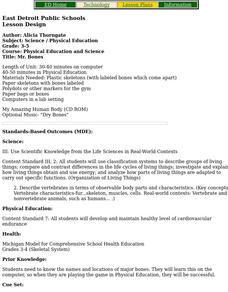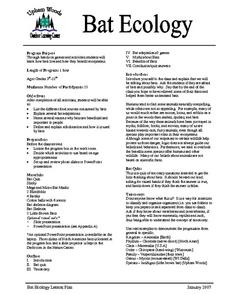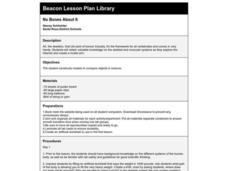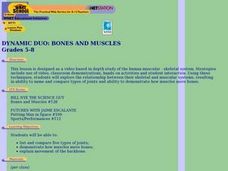Nuffield Foundation
Investigating Factors Affecting the Heart Rate of Daphnia
What variables change heart rate? Young scientists observe the beating heart in Daphnia to understand these variables. They make changes in temperature, chemicals, and other factors as they graph the heart rates. Analysis questions help...
American Museum of Natural History
What do You Know About Life on Earth?
Humans have only inhabited the earth for a fraction of the time that life has existed. Young scientists explore the facts about the emergence of life on Earth with an interactive resource. While highlighting different types of life, the...
Curated OER
Week 8 - Sea Life
Using a magnifier, mini marine biologists examine the barbules of a bird feather. They swirl the it into a mixture of oil and water and then re-examine the feather. After the activity, discuss how the oily feathers pose a problem to sea...
Curated OER
Animal-mania
Learners explore the concept of scientific classification systems using a guided Internet research activity. They answer specific questions on the classification of animals by exploring a different Internet link for each question.
Out of Africa Wildlife Park
A Thematic Learning Guide to Lions
Written as an accompaniment to a field trip to the Out of Africa Wildlife Park in Arizona, this is an interdisciplinary, themed lesson on lions. Even if you cannot take your upper-elementary kids to this attraction, there are a few...
Curated OER
What's the Difference?
Students analyze the similarities in different species. This lesson plan is part of a multi-segmented unit on the diversity of life. In this segment, students classify shoes to mimic the scientific categories of the classification system.
Curated OER
Whales
First graders investigate two different types of whales; toothed and baleen. They describe what the different types of whale eat. They listen to a cassette of Dyan Sheldon's, The Whale Song before making stick puppets to dramatize the...
Curated OER
Turtle Shell Craft
Have your class learn about turtles and adaptation using this lesson. Learners discuss turtles, the unique design of their shells, and the ways they have adapted to their surroundings. Then, they make a paper bag model to simulate a...
Irish Osteoporosis Society
Osteoporosis
Osteoporosis has long been viewed as an "old ladies' disease," but there are many people at risk. There are also many things young people can do to reduce their risk factors. Learn about all of this and more through a comprehensive...
Curated OER
Animal Classification
In this animal classification worksheet, students read for information and comprehension. In this fill in the blank and multiple choice worksheet, students answer five questions.
Curated OER
Mr. Bones
Students play CD-ROM game My Amazing Human Body, and participate in relay game in Phys. Ed. where they put together skeleton on which body parts are labeled.
Curated OER
Crossword: Rain Forest
In this crossword worksheet, students solve a crossword puzzle by solving clues about the Rain Forest. For example, "The area or environment where an animal lives."
Curated OER
Let Me Tell You About My Favorite Animal
Students create books about their favorite animals using graphic organizers.
Curated OER
Time Machine: Evolution, Geology
Students are taken on a simulated "voyage" backward in time, to the beginning of our planet. They "witness" that beginning, the origin of life, and a number of key events from then to the present.
Curated OER
Shark Attack
Students study the white shark and the red triangle. In this critical thinking lesson students assess the validity of facts about sharks and create a public service announcement either promoting shark or human protection.
Curated OER
What Can You Learn About Dinosaurs by Watching an Ostrich?
Students collect a variety of drawings of dinosaurs and maps of a zoo. Students observe an animal in motion during a field trip to a zoo from reproducible worksheets. Students study about the process by which scientists and film...
Curated OER
Bat Ecology
Students, through hands on games and activities, discover how bats live and how bats benefit ecosystems. They play a game designed to show them how echolocation works and another to show how mother bats locate their young through their...
Curated OER
Raising Trout
Students investigate the life cycles of fish as they observe a trout's life in class. In this fish life lesson, students create a proper habitat in a fish tank for the trout eggs to spawn and thrive for several weeks. Students record...
Curated OER
It's All in the Rocks
Students think critically to determine fact or inference when examining sedimentary layers with embedded fossils. They are being introduced to geology as well as evolutionary biology.
Curated OER
Arthropod Coloring Worksheet
In this biology worksheet, learners color and label the different parts of arthropods. They complete 63 short answer and fill in the blank questions on arthropods.
Curated OER
The Froggy Page
Students investigate the cycle of life by observing tadpoles. In this biology lesson, students utilize the Internet to read stories, observe pictures, and listen to sounds of frogs. Students create a poster board collage using frog...
Curated OER
No Bones About It
Students conduct Internet research on the different parts of the skeletal system. Then they create a model arm that demonstrates how muscle and bone work together to create movement.
Curated OER
Dynamic Duo: Bones and Muscles
Students explore the relationship between their skeletal and muscular systems, resulting in ability to name and compare types of joints and ability to demonstrate how muscles move bones.
Curated OER
Dinosaurs are for the Birds
Students use the Internet to see photographs of fossils from dinosaurs. They read articles about dinosaurs and birds and what they had in common. They also examine a dinorama site in which they discover why some dinosaurs needed feathers.

























